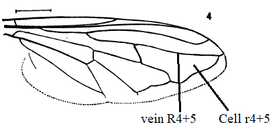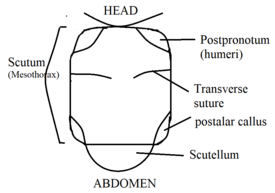| Blera armillata | |
|---|---|
| Scientific classification | |
| Domain: | Eukaryota |
| Kingdom: | Animalia |
| Phylum: | Arthropoda |
| Class: | Insecta |
| Order: | Diptera |
| Family: | Syrphidae |
| Subfamily: | Eristalinae |
| Tribe: | Milesiini |
| Genus: | Blera |
| Species: | B. armillata |
| Binomial name | |
| Blera armillata (Osten Sacken, 1875) | |
| Synonyms | |
| |
Blera armillata, the orange-faced wood fly, is an uncommon species of syrphid fly first officially described by Osten Sacken in 1875. Hoverflies get their names from the ability to remain nearly motionless while in flight. The adults are also known as flower flies for they are commonly found around and on flowers, from which they get both energy-giving nectar and protein-rich pollen. The larvae are of the rat-tailed type, feeding on exuding sap or in the rot holes of trees.
Distribution
Widely distributed in North America
Description
For terms see Morphology of Diptera.
The combination of entirely black abdomen, pale scutum and black gena distinguishes this from most other Blera .
- Length 10–14 mm
- Head
The face and front above the antennae are honey-yellow. There is a black spot on the gena. The upper part of front and vertex are blackish-bronze in color, with some dull orange. The antennae are yellow with a black arista.
- Thorax
The scutum, scutellum and postpronotum are a greenish-bronze color, clothed with erect dull orange pile. The pleurae areblack.
- Abdomen
The abdomen is black, shining and clothed with black pile. There is a small tuft of yellow pile on each side at the base.
- Wing
Two-thirds of the wings near the thorax are tinged with yellow, the remainder is gray extends along the posterior margin as far as the axillary incision. The vein R4+5 is almost straight and joins the costa (C) just before the tip of the wing. The first posterior cell (r4+5) is acute apically and extends almost to the wing margin before the tip. The halteres (#9) are yellow.
- Legs
The coxa and about two thirds of the femur are black with the end of the femur yellow. The tibiae are mostly yellow, a black ring in the middle. The three basal joints of the tarsi are of a yellow. The last two tarsal joints are black.
References
- ^ Osten Sacken, Karl Robert (1875). "A list of the North American Syrphidae". Bulletin of the Buffalo Society of Natural Sciences. 3: 38–71. Retrieved 22 July 2021.
 This article incorporates text from this source, which is in the public domain.
This article incorporates text from this source, which is in the public domain.
- ^ Curran, Charles Howard (1925). "Contribution to a monograph of the American Syrphidae north of Mexico". The Kansas University science bulletin. (1924) 15: 7–216, 12 pls. Retrieved 23 July 2021.
 This article incorporates text from this source, which is in the public domain.
This article incorporates text from this source, which is in the public domain.
- Curran, Charles Howard (1953). "Notes and descriptions of some Mydaidae and Syrphidae" (PDF). American Museum Novitates. 1645: 1–15.
- Skevington, Jeffrey H (2019). Field Guide to the Flower Flies of Northeastern North America. ISBN 9780691189406.
| Taxon identifiers | |
|---|---|
| Blera armillata | |
This article relating to Milesiini is a stub. You can help Misplaced Pages by expanding it. |




